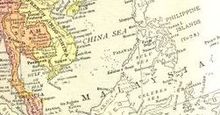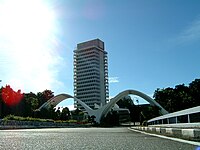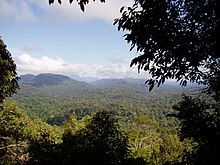Malaysia
From jeena
This article is about the country. For the biogeographical region, see Malesia.
| Malaysia | ||||||
|---|---|---|---|---|---|---|
|
||||||
| Motto: "Bersekutu Bertambah Mutu" "Unity Is Strength"[1] |
||||||
| Anthem:
Negaraku "My Country" |
||||||
 |
||||||
| Capital (and largest city) |
Kuala Lumpur[a] Putrajaya (administrative centre) 3°08′N 101°42′E |
|||||
| Official language(s) | Malaysian[b] | |||||
| Official script | Latin alphabet[c] | |||||
| Used for some purposes | English[d] | |||||
| Ethnic groups | 50.4% Malay 23.7% Chinese 11.0% Indigenous 7.1% Indian 7.8% Other[2] |
|||||
| Demonym | Malaysian[3] | |||||
| Government | Federal constitutional elective monarchy and Federal parliamentary democracy | |||||
| - | King | Abdul Halim | ||||
| - | Prime Minister | Najib Tun Razak (BN) | ||||
| - | Deputy Prime Minister | Muhyiddin Yassin (BN) | ||||
| Legislature | Parliament | |||||
| - | Upper house | Dewan Negara | ||||
| - | Lower house | Dewan Rakyat | ||||
| Independence | From the United Kingdom | |||||
| - | Malaya | 31 August 1957[4] | ||||
| - | Sarawak | 22 July 1963[5] | ||||
| - | North Borneo[e] | 31 August 1963[6] | ||||
| - | Federation of Malaya, North Borneo, Sarawak, and Singapore[f] | 16 September 1963 | ||||
| Area | ||||||
| - | Total | 329,847 km2 (67th) 127,355 sq mi |
||||
| - | Water (%) | 0.3 | ||||
| Population | ||||||
| - | 2010 census | 28,334,135[7] (42th) | ||||
| - | Density | 86/km2 (114th) 216.45/sq mi |
||||
| GDP (PPP) | 2012 estimate | |||||
| - | Total | $472.942 billion[8] | ||||
| - | Per capita | $16,186[8] | ||||
| GDP (nominal) | 2012 estimate | |||||
| - | Total | $278.680 billion[8] | ||||
| - | Per capita | $10,466[8] | ||||
| Gini (2002) | 46.1[2] (36th) | |||||
| HDI (2011) | ||||||
| Currency | Ringgit (RM) (MYR) |
|||||
| Time zone | MST (UTC+8) | |||||
| - | Summer (DST) | Not observed (UTC+8) | ||||
| Date formats | dd-mm-yyyy | |||||
| Drives on the | Left | |||||
| ISO 3166 code | MY | |||||
| Internet TLD | .my | |||||
| Calling code | +60 | |||||
| ^ a. Kuala Lumpur is the capital city and is home to the legislative branch of the Federal government. Putrajaya is the primary seat of the federal government where the executive and judicial branches are located.
^ b. The terminology as per government policy is Bahasa Malaysia (literally Malaysian language)[10] but legislation continues to refer to the official language as Bahasa Melayu (literally Malay language).[11] ^ c. Under the National Language Act 1967: "The script of the national language shall be the Rumi [Latin] script: provided that this shall not prohibit the use of the Malay script, more commonly known as the Jawi script, of the national language."[12] ^ d. English may be used for some purposes under the National Language Act 1967. ^ e. Before the accession, Sabah was referred to as North Borneo. ^ f. Singapore became an independent country on 9 August 1965.[13] |
||||||
Malaysia has its origins in the Malay Kingdoms present in the area which, from the 18th century, became subject to the British Empire. The first British territories were known as the Straits Settlements, whose establishment was followed by the Malay kingdoms becoming British protectorates. The territories on Peninsular Malaysia were first unified as the Malayan Union in 1946. Malaya was restructured as the Federation of Malaya in 1948, and achieved independence on 31 August 1957. Malaya united with Sabah, Sarawak, and Singapore on 16 September 1963, with si being added to give the new country the name Malaysia. Less than two years later in 1965, Singapore was expelled from the federation. Since independence, Malaysia has had one of the best economic records in Asia, with GDP growing an average 6.5% for almost 50 years. The economy has traditionally been fuelled by its natural resources, but is expanding in the sectors of science, tourism, commerce and medical tourism.
The country is multi-ethnic and multi-cultural, which plays a large role in politics. The government system is closely modelled on the Westminster parliamentary system and the legal system is based on English Common Law. The constitution declares Islam the state religion while protecting freedom of religion. The head of state is the King, known as the Yang di-Pertuan Agong. He is an elected monarch chosen from the hereditary rulers of the nine Malay states every five years. The head of government is the Prime Minister.
Malaysia contains the southernmost point of continental Eurasia, Tanjung Piai. Located in the tropics, it is a megadiverse country, with large numbers of endemic flora and fauna. It is a founding member of the Association of Southeast Asian Nations and the Organisation of Islamic Cooperation, and a member of Asia-Pacific Economic Cooperation, the Commonwealth of Nations, and the Non-Aligned Movement.
Contents
|
Etymology

Following his 1826 expedition in Oceania, French navigator Jules Dumont d'Urville invented the terms Malaysia, Micronesia and Melanesia, distinguishing these Pacific cultures and island groups from the existing term Polynesia. In 1831, he proposed these terms to the Société de Géographie. Dumont d'Urville described Malaysia as "an area commonly known as the East Indies".[21] In 1850, the English ethnologist George Samuel Windsor Earl, writing in the Journal of the Indian Archipelago and Eastern Asia, proposed naming the islands of Southeast Asia as Melayunesia or Indunesia, favouring the former.[22]
In 1957, the Federation of Malaya was declared as an independent federation of the Malay states on the Malay Peninsula.[23] The name "Malaysia" was adopted in 1963 when the existing states of the Federation of Malaya, plus Singapore, North Borneo and Sarawak formed a new federation, with "si" being added to Malaya in honour of the three joining states.[24] Prior to that, the name itself had been used to refer to the whole Malay Archipelago.[25] Politicians in the Philippines contemplated renaming their state "Malaysia" before the modern country took the name.[26] At the time of federation, other names were considered: among them was Langkasuka, after the historic kingdom located at the upper section of the Malay Peninsula in the 1st millennium CE.[27]
History
Main article: History of Malaysia
Evidence of modern human habitation in Malaysia dates back 40,000 years.[28] The first inhabitants are thought to be Negritos.[29]
Traders and settlers from India and China arrived as early as the 1st
century AD, establishing trading ports and coastal towns in the 2nd and
3rd centuries. Their presence resulted in strong Indian and Chinese
influence on the local cultures, and the people of the Malay Peninsula
adopted the religions of Hinduism and Buddhism. Sanskrit inscriptions appear as early as the 4th or 5th century.[30] The Kingdom of Langkasuka arose around the 2nd century in the northern area of the Malay Peninsula, lasting until about the 15th century.[27] Between the 7th and 13th centuries, much of the southern Malay Peninsula was part of the maritime Srivijaya empire. After the fall of Srivijaya, the Majapahit empire had influence over most of Peninsular Malaysia and the Malay Archipelago.[31] Islam began to spread among Malays in the 14th century.[3] In the early 15th century, Parameswara, a prince of the former Srivijayan empire, founded the Malacca Sultanate, commonly considered the first independent state in the peninsula.[32]
Malacca was an important commercial centre during this time, attracting
trade from around the region. Parameswara became a Muslim, accelerating
the spread of Islam.[3]
In the Second World War the Japanese army invaded and occupied Malaya, Sabah, Sarawak, and Singapore for over three years. During this time, ethnic tensions were raised and nationalism grew.[38] Popular support for independence increased after Malaya was reconquered by Allied Forces.[39] Post-war British plans to unite the administration of Malaya under a single crown colony called the Malayan Union met with strong opposition from the Malays, who opposed the weakening of the Malay rulers and the granting of citizenship to the ethnic Chinese. The Malayan Union, established in 1946 and consisting of all the British possessions in the Malay Peninsula with the exception of Singapore, was quickly dissolved and replaced by the Federation of Malaya, which restored the autonomy of the rulers of the Malay states under British protection.[40] During this time, mostly Chinese rebels under the leadership of the Malayan Communist Party launched guerrilla operations designed to force the British out of Malaya. The Malayan Emergency lasted from 1948 to 1960, and involved a long anti-insurgency campaign by Commonwealth troops in Malaya.[41] After this a plan was put in place to federate Malaya with the British crown colonies of Sabah, Sarawak, and Singapore. The proposed date of federation was 31 August 1963, however, the date was delayed until 16 September 1963 due to opposition from Indonesia's Sukarno and the Sarawak United Peoples' Party.[42]

Governance
Main article: Politics of Malaysia

Legislative power is divided between federal and state legislatures. The bicameral federal parliament consists of the lower house, the House of Representatives and the upper house, the Senate.[51] The 222-member House of Representatives is elected for a maximum term of five years from single-member constituencies. All 70 senators sit for three-year terms; 26 are elected by the 13 state assemblies, and the remaining 44 are appointed by the King upon the Prime Minister's recommendation.[3] The parliament follows a multi-party system and the government is elected through a first-past-the-post system. Since independence Malaysia has been governed by a multi-party coalition known as the Barisan Nasional.[3]
Each state has a unicameral State Legislative Assembly whose members are elected from single-member constituencies. State governments are led by Chief Ministers,[3] who are state assembly members from the majority party in the assembly. In each of the states with a hereditary ruler, the Chief Minister is required to be a Malay, appointed by the ruler upon the recommendation of the Prime Minister.[52] Parliamentary elections are held at least once every five years, the most recent of which took place in March 2008.[3] Registered voters of age 21 and above may vote for the members of the House of Representatives and, in most of the states, for the state legislative chamber. Voting is not mandatory.[53] Except for elections in Sarawak, all state elections are held concurrently with the federal election.[50]

Malaysia's legal system is based on English Common Law.[3] Although the judiciary is theoretically independent, its independence has been called into question and the appointment of judges lacks accountability and transparency.[55] The highest court in the judicial system is the Federal Court, followed by the Court of Appeal and two high courts, one for Peninsular Malaysia and one for East Malaysia. Malaysia also has a special court to hear cases brought by or against Royalty.[56] Separate from the civil courts are the Syariah Courts, which apply Shariah law to cases which involve Malaysian Muslims[57] and run parallel to the secular court system.[58] The Internal Security Act allows detention without trial, and the death penalty is in use for crimes such as drug trafficking.[59]
Race is a significant force in politics, and many political parties are ethnically based.[3] Actions such as the New Economic Policy[46] and the National Development Policy which superseded it, were implemented to advance the standing of the bumiputra, consisting of Malays and the indigenous tribes who are considered the original inhabitants of Malaysia, over non-bumiputra such as Malaysian Chinese and Malaysian Indians.[60] These policies provide preferential treatment to bumiputra in employment, education, scholarships, business, and access to cheaper housing and assisted savings. However, it has generated greater interethnic resentment.[61] There is ongoing debate over whether the laws and society of Malaysia should reflect secular or Islamic principles.[62] Islamic laws passed by the Pan-Malaysian Islamic Party in state legislative assemblies have been blocked by the federal government.[63]
Foreign relations and military
Main articles: Foreign relations of Malaysia and Malaysian Armed Forces

Malaysia's foreign policy is officially based on the principle of neutrality and maintaining peaceful relations with all countries, regardless of their political system.[72] The government attaches a high priority to the security and stability of Southeast Asia,[71] and seeks to further develop relations with other countries in the region. Historically the government has tried to portray Malaysia as a progressive Islamic nation[72] while strengthening relations with other Islamic states.[71] A strong tenet of Malaysia's policy is national sovereignty and the right of a country to control its domestic affairs.[50]
The policy towards territorial disputes by the government is one of pragmatism, with the government solving disputes in a number of ways, such as bringing the case to the International Court of Justice.[73] The Spratly Islands are disputed by many states in the area, although tensions have eased since the 2002 Declaration on the Conduct of Parties in the South China Sea. Brunei and Malaysia in 2008 announced an end to claims of each other's land, and to resolve issues related to their maritime borders. The Philippines has a dormant claim to Sabah. Singapore's land reclamation has caused tensions, and maritime border disputes exist with Indonesia.[74]

The Malaysian Armed Forces have three branches, the Royal Malaysian Navy, the Malaysian Army, and the Royal Malaysian Air Force. There is no conscription, and the required age for voluntary military service is 18. The military uses 1.9 per cent of the country's GDP, and employs 1.23 per cent of Malaysia's manpower.[79]
The Five Power Defence Arrangements is a regional security initiative which has been in place for almost 40 years. It involves joint military exercises held among Malaysia, Singapore, Australia, New Zealand, and the United Kingdom.[80] Joint exercises and war games have been held with Indonesia for years.[81] Malaysia and the Philippines have agreed to host joint security force exercises in order to secure their maritime border and tackle issues such as illegal immigration.[82] There are fears that unrest in the Muslim areas of the southern Philippines[83] and southern Thailand[84] could spill over into Malaysia.
Subdivisions
Main articles: States and federal territories of Malaysia and Districts of Malaysia

Perlis
Kedah
Penang
Kelantan
Terengganu
Perak
Selangor
Negeri Sembilan
Malacca
Johor
Pahang
Sarawak
Sabah
Labuan
Kuala Lumpur
Putrajaya
West Malaysia
East Malaysia
Federal Territory
South China Sea
Strait
of Malacca
Gulf of Thailand
Sulu Sea
Celebes Sea
Brunei
Indonesia
Indonesia
Singapore
Thailand
|
The 13 states are based on historical Malay Kingdoms, and 9 of the 11 Peninsular states, known as the Malay states, retain their royal families. The King is elected by and from the nine rulers to serve a five-year term.[3] Each state has a unicameral legislature known as the State Legislative Assembly. The states of East Malaysia (Sabah and Sarawak) have separate immigration policies and controls, and a unique residency status.[86] For citizens of one of these states or Peninsular Malaysia, the other areas of Malaysia are considered foreign countries under immigration laws.[87] Each state is further divided into districts, which are then divided into mukim. In Sabah and Sarawak districts are grouped into divisions.[88]
The federal parliament is permitted to legislate on issues of land, the Islamic religion and local government, in order to provide for a uniform law among all states. It may also intervene at the request of the state assembly concerned. Except for some land related laws, the in question must also be passed by the state assembly. Non-Islamic issues that fall under the purview of the state may also be legislated at the federal level for the purpose of conforming with Malaysian treaty obligations.[89]
Geography
Main article: Geography of Malaysia

The two parts of Malaysia, separated from each other by the South China Sea, share a largely similar landscape in that both Peninsular and East Malaysia feature coastal plains rising to hills and mountains.[2] Peninsular Malaysia, containing 40 per cent of Malaysia's land area,[93] extends 740 kilometres (460 mi) from north to south, and its maximum width is 322 kilometres (200 mi).[96] It is divided between its east and west coasts by the Titiwangsa Mountains,[97] part of a series of mountain ranges running down the centre of the peninsula.[93] These mountains are heavily forested,[98] and mainly composed of granite and other igneous rocks. Much of it has been eroded, creating a karst landscape.[93] The range is the origin of some of Peninsular Malaysia's river systems.[98] The coastal plains surrounding the peninsula reach a maximum width of 50 kilometres (31 mi), and the peninsula's coastline is nearly 1,931 kilometres (1,200 mi) long, although harbours are only available on the western side.[96]

Around these two halves of Malaysia are numerous islands, the largest of which is Banggi.[101] The local climate is equatorial and characterised by the annual southwest (April to October) and northeast (October to February) monsoons.[96] The temperature is moderated by the presence of the surrounding oceans.[93] Humidity is usually high, and the average annual rainfall is 250 centimetres (98 in).[96] The climates of the Peninsula and the East differ, as the climate on the peninsula is directly affected by wind from the mainland, as opposed to the more maritime weather of the East. Local climates can be divided into three regions, highland, lowland, and coastal. Climate change is likely to affect sea levels and rainfall, increasing flood risks and leading to droughts.[93]



No comments:
Post a Comment